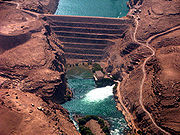NEW: 23-June.
President Karzai strongly criticized ISAF tactics that lead to civilian deaths.
--------------------------------------------------------------------------------------------
Karzai criticized the ISAF "extreme" use of force and stated that "Innocent people are becoming victims of reckless operations". This statement comes after several incidents at Uruzgan and Helmand (see below) [BBC News 23-June] [Le Monde 23-June] [AfghaNews 23-June].
Karzai also said that "Afghan life is not cheap and it should not be treated as such" and "Several times in the last year, the Afghan government tried to prevent civilian casualties, but our innocent people are becoming victims of careless operations of NATO and international forces,".
"We want to cooperate with the international community. We are thankful for their help to Afghanistan," Karzai said. "But that does not mean that Afghan lives have no value." [Yahoo News] [Afgha News 23-June] . ISAF spokesman Nick Lunt responded that: "President Karzai has a right to be disappointed and angry over the scale of civilian casualties in the last few days," "We need to do better than we have been doing so far." [Yahoo News].
--------------------------------------------------------------------------------------------
NATO-ISAF military operations have lead to repetitive incidents of civilian deaths and friendly fire casualties. This situation is undermining the support of afghan population to the government and the NATO-ISAF.
In the last months there have been several serious incidents of different nature: NATO soldiers shooting to civilians after explosive device attacks, NATO aircraft attacks to civilian areas, and NATO forces attacked afghan police.
The main incidents have been the following:
- March 4 2007: US Marine Special Forces opened fire on civilians while fleeing an ambush in the busy Jalalabad-Pakistan highway. This lead to 16 people killed and 34 wounded. At the beginning the
Afghan and U.S. reports on firefight differed. Afghan authorities confirmed the incident [
AfghaNews 4-March]. And, finally, the US command recognized the incident and a
US colonel 'deeply ashamed' over Afghan civilian deaths.
- April 29 2007: Air strikes and attacks at Zerkoh valley (Herat Province), in clashes between US forces and local population. This lead to about 50 people dead and important damages. The case is detailed in
Civilians killed by NATO at Afghanistan : the case of Zerkoh Valley (Shindand, Herat).
- May 8 2007: Air strikes at Sangin (Helmand Province) killed at least 21 civilians including women and children [
AfghaNews 9-May] [
AfghaNews 10-May] [
AfghaNews 11-May] .
- June 11 2007: US forces killed afghan 7 policeman at a checkpoint in Nangarhar Province. It seems that the police checkpoint thought that the US forces were the enemy, so police opened fire, and then the coalition thought that the enemies were firing on them, so they returned fire back [
AfghaNews 12-June]. The afghan police didn't know about the US forces operation.
- June 16 2007: Shooting at Kabul after the suicide bombing. A US soldier opened fire afterward, and killed one civilian [
AfghaNews 16-June].
- June 17 2007: Air strike to a madrassa at Zarghon Shah District (Paktika Province) killed 7 children [
AfghaNews 18-June] [
GlobalSecurity 18-June].
- June 18 2007: Combats at Uruzgan province may have lead to about 30-60 civilians dead [
Bassirat 19-June] [
Aljazeera 19-June] . According to [
Yahoo News], 52 civilians died when artillery was fired to the town of
Chora. Concerning this case, President Karzai said that "You do not fight terrorists by firing a field gun 20 miles into a target,". "That is definitely surely bound to cause civilian casualties.
- June 22 2007: Air strike to the village of Adam Khan at Gershk district (Helmand province) killed 25 civils (including 9 women and 3 childs). The strike was confirmed by ISAF. [
Bassirat 22-June]
The reasons or the incidents seem to be a mix of: inaccurate intelligence information, prevent own (NATO) casualties, lack of confidence on afghan partners, and lack of concern about afghan civilian lives.
These incidents have generated multiple reactions.
President Karzai strongly criticized ISAF tactics, and claimed for respecting afghan civilian lives (see above).
On NATO side, there are concerns about the political consequences as well as it image. [
IHT] . In addition, goodwill toward foreign forces is eroding across Afghanistan because airstrikes, an umbrella group for aid agencies said Tuesday. [
AfghaNews 19-June].
NATO Secretary-General Jaap de Hoop Scheffer said that "concrete measures" must be taken by NATO to reduce civilian casualties [
NATO Focuses On Reducing Civilian Casualties].
The International Committee of the Red Cross has also criticized NATO because of killing dozens of civilians with air strikes against insurgents carried out without enough precaution for nearby civilians.
In [
Analysis: Hearts, Minds, and Afghan Body Counts], Lionel Beehner (
Council on Foreign Relations), the Western "battle for Afghans’ hearts and minds may be suffering from large-scale collateral damage". The scores of civilians killed by coalition forces (Economist.com) in recent months, is resulting in growing anti-Americanism among Afghans.
Ahmed
Rashid, in an interview, stated that if OTAN proceeds on with the politics of air strikes during all 2007, it will loose the war against the Talibans [Bassirat 31-May].
RAWA publishes a "Summary of Civilian Deaths Resulting from US/NATO Military Actions in Afghanistan".

